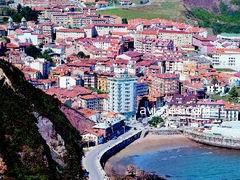
_________________________________________________________________
Personal Travel
CHANGING Places
(Part II)
____________________________________________________________________________________
On the second day of my trip, I drove into the sleepy port town of Carreño. By all appearances, it was an ancient fishing village, frayed and down on its luck. The ''down on its luck'' bit was a no-brainer. The ''fishing village'' ID was also right -- up to a point. Carreño HAD been a fishing village -- a major exporter of cod -- until Seit, the Spanish division of the Italian auto maker Fiat, built a plant on the town´s outskirts and invited the town´s labourers -- mostly fisherman, up to that point -- to swap their nets for rivet guns. That was fine until a few years ago when Seit started laying off workers and the local economy --always dodgy in northern Spain, anyway -- took a further nosedive.
Today, local labourers -- fishermen turned autoworkers -- are largely neither. Sadly, the numbers of unemployed are plentiful, and many non-workers spend their days in clusters around Carreño´s picturesque harbourside. At night, the crowds near the harbour are equally thick. After a paella dinner one night along the harbour pier, at a restaurant just up from the Carreño Yacht Club (actually, a restaurant and nightspot), I was eager to fall into bed after a long day.
My suite at the Hotel Marsol refused to cooperate. The octagonal room was mirrored from wall to wall, a Spaniard´s, if not an Arab´s, dream, of course, of a squank seraglio. Flowing coloured-neon ''lava'' oozed in light lamps at my bedside night tables. By pushing a button, my bed pulsated. You get the idea, Splendid, tacky 50´s retro, which only the Spanish do so well. (OK, Mexicans might be up there, as well).
As I drifted into sleep, finally, I was awakened, time after time, by squads of drunkards below my window, bellowing in chorus with howling dogs. Someone made sleeping even more difficult by throwing stones on nearby red tile roofs.
If anyone in Carreño thought this visit by a Carreño something special -- perhaps, I thought, something akin to a wandering native´s return to ancestral roots -- well, no one let on. In fact, the only stares I received was when, popping into a tabacconist´s shop, I bought about 100 postcards, all that were on offer. Why this "Englishman'' -- AMERICANS, apparently, are seldom seen in Carreño -- was buying all the postal cards was the only singular bit that piqued the shopkeeper´s interest. This, even after I explained that I was a representative of the Carreño family branch of Toribio and Maria Elena Carreño, ALL the way from America. (Actually, a bit of white lie since, at the time, I was living in London). ''Sí, sí,'' the shopkeeper seemed to say. ''I understand the Carreño bit. But why ALL the post cards?''
[Richard Carreño is the son of Ralph Carreño and Marion Carreño. He has three children, Abigail Carreño, Justin Toribio Carreño, and Hunter Carreño IV).
(This part is the last in a two-part series).